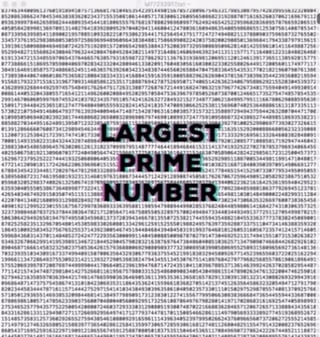How to Screen Mirror iPhone 17
iPhone 17 makes screen sharing and media streaming fast and easy. This guide shows you how to wirelessly mirror iPhone 17 to TVs, projectors or...
1 min read
Tom Crilley Jan 4, 2018 10:37:12 AM
Squirrels built a supercomputer in 2015 to help find the largest and rarest prime numbers ever discovered. We're excited to announce today the discovery and verification of a prime number that's over 23 million digits long!
The newly discovered prime number is 277,232,917-1. It's calculated by multiplying 77,232,917 twos together and subtracting one.
This type of prime number, which takes the form 2P-1, is identified as a Mersenne prime. For example, while the smallest traditional prime numbers are 2, 3, 5, 7, etc., the smallest Mersenne primes are 3, 7, 31 and 127 calculated with P values of 2, 3, 5 and 7.
Squirrels' supercomputer contributes computing power to the Great Internet Mersenne Prime Search (GIMPS). This search is a coordinated global effort that combines the power of thousands of computers to find the largest prime numbers ever discovered.

Squirrels was also one of the groups tasked with verifying the new prime number. This marks the second time the Squirrels supercomputer contributed to a Mersenne prime discovery. It previously helped verify a prime with more than 22 million digits in January 2016.
"We are happy that we are able to contribute not just to the prime search, but to many educational and research projects," Squirrels founder David Stanfill said. "I hope our contribution can help inspire the next generation of curious thinkers."
The next major GIMPS goal is to find the first 100 million-digit prime number. That one comes with a $150,000 award.
How to get involved
Anyone with a moderately powerful computer can download the free GIMPS software needed to contribute to the search and potentially earn money for new discoveries.
K-12 educators are bringing the prime number search to the classroom to get students excited about the power of mathematics and teach them about collaborative computing.
Learn how to get started at https://www.mersenne.org.
Learn More
Read the full GIMPS press release for complete details about the latest prime number discovery and user contributions.


iPhone 17 makes screen sharing and media streaming fast and easy. This guide shows you how to wirelessly mirror iPhone 17 to TVs, projectors or...

HDMI cables. Document cameras. DVD players. Dongles and adapters. Many classrooms still rely on these old technologies, but students and educators...

Digital signage is getting easier every day thanks to AI-powered design tools and signage management software. This guide helps schools and business...

We’re excited to announce that one of our workplace hobbies recently contributed to a monumental discovery in mathematics.

Earlier this month, the Squirrels supercomputer verified the largest prime number discovered to date. The prime is unfathomably large at 22,338,618...
![Think That Meeting Was a Waste of Time? You're Not Alone [Infographic]](https://blog.airsquirrels.com/hubfs/Blog%20Images/B295%20-%20Unproductive%20Meetings%20Infographic/Featured-Image.png)
Do you dread checking your work calendar each morning? Do you scroll through the list of meeting requests, rescheduled start times, location changes...


Save when you buy AirParrot and Reflector together. One AirParrot and one Reflector license for use on either MacOS or Windows.
BUY US$

Save when you buy AirParrot and Reflector together. One AirParrot and one Reflector license for use on either MacOS or Windows.
BUY US$